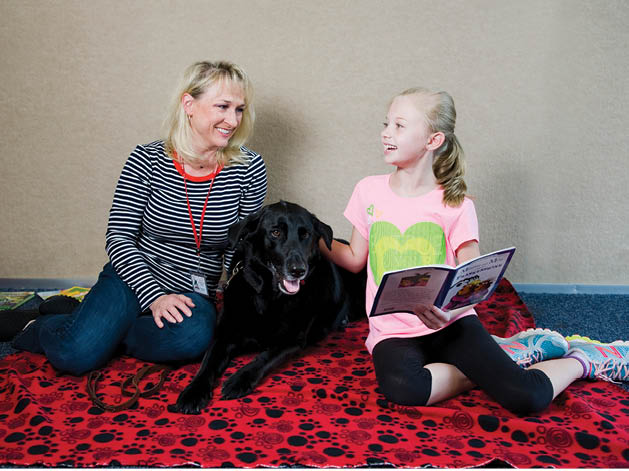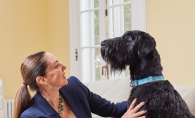Lesa Hobright-Turner says she is “one of those people who will always have a dog.” After the family dog passed away in 1995, she began frequenting the Animal Humane Society in Woodbury “just to get my dog fix,” she says. It was there that she met Murphy, a surprisingly composed German Shepherd/Lab pup who charmed her instantly and would eventually change her life.
Within a month, Hobright-Turner (with the help of her sixth-grader, Brexton) was convincing her husband that the shelter dog she had her eye on was not going to get that much bigger. Topping out at 100 pounds (much bigger than originally anticipated), the gentle giant that chose Hobright-Turner nine years ago has a glossy black coat and gentle brown eyes, as well as a penchant for beef jerky, which has been known to draw the slobber to his jowls, and tennis balls, which he has a somewhat irksome habit of hiding underneath furniture.
After leaving her position as director of clinical affairs for a medical device company in 2013, Hobright-Turner has been able to devote more time to sharing her canine with the community. Murphy’s unique intelligence and vast reserve of interspecies compassion have led to ongoing therapy animal engagements, including Middleton Elementary School’s R.E.A.D. program, the University of Minnesota’s Pet Away Worries and Stress program, as well as several assisted living facilities. Murphy and Hobright-Turner became a Pet Partners-registered therapy animal team in 2014, and that same year, Murphy was inducted into the Minnesota Veterinary Medical Association Hall of Fame as Companion Animal of the Year.
The Making of Murph
Murphy’s intelligence and trainability were evident from the very beginning. When the family set about house-training him, Murphy patiently demonstrated that no such training was necessary, and sat quietly by the door until they got the message. Recognizing her dog’s potential—as well as his need for constant intellectual stimulation—Hobright-Turner put Murphy through a series of obedience classes at All Breed Obedience behavioral school for dogs in Woodbury. At this family-owned operation, Hobright-Turner was introduced to a communication-based (rather than control-based) approach to training, which relies on signals, voice commands, and a thorough understanding of canine body language and psychology.
All Breed’s co-owner and lead trainer, Deb Schneider, says that Hobright-Turner and Murphy display all the qualities of a great therapy team. “More than anything, we work on getting people to understand their dogs,” Schneider says. “Once they understand them, the rest comes easily. With Murphy, as he went along in his training, it was easy to see that he was on the right track; he was an easy train and he trusted his owner. I knew that they were going to do well, because there was a clear bond between them.” Schneider also noted that Murphy was not only highly “biddable” or trainable, predictable and impeccably composed, but also possessed the ideal personality profile for a therapy animal. “Therapy dogs aren’t made, they’re born,” she says, and notes that the most important quality of a therapy dog is sociability. “I have to remind people—it should make the dog happy. The dog should actively want to be walking up to somebody.”


Murph at Work
Murphy’s outgoing character emerged when he was only a puppy, on the sidelines at his human brother’s lacrosse games. “He would work the crowd with his gooey tennis ball,” Hobright-Turner says, and he rapidly became something of an unofficial team mascot.
Some of Murphy’s most fruitful networking occurred this past year at Woodbury’s Dale Road Dog Park, where he befriended a dog named Gunner whose owner, Ginger Garry, happens to be a teacher at Middleton Elementary School. Garry was immediately taken with the big black dog and when she heard about Murphy’s therapy animal training, she pitched the idea of “Mondays with Murphy” to her school’s principal, who approved.
Hobright-Turner and Murphy began the Reading Education Assistance Dogs (R.E.A.D.) program in the summer of 2014, and continue to visit Mrs. Garry’s second grade class twice a week (much to the envy of the other students in that grade level). During each one-hour session, three students have an individual session with Murphy in a quiet spot outside the classroom. Murphy listens as they read, sometimes doling out encouraging kisses and well-timed sneezes, or placing his wet nose on the page. Hobright-Turner, who supervises these sessions, says that Murphy’s ability to instantly gauge a child’s comfort level is astounding. “He always positions himself in a way that will not intimidate them,” she says.
Garry observes that Murphy’s harmless demeanor has helped some of her students overcome their fear of dogs, and there is not a single student who is not excited about the program each week. “They love it; they just can’t wait,” Garry says. “They like it because they can read, and he doesn’t correct them. It helps build their confidence, and they don’t even realize it [is helping] them.” She adds, “Murphy loves it, too. He gets belly rubs, back scratches and everything else he adores. I wish my dog could come into the classroom, but that wouldn’t work at all. Murphy is something special.”
Murph U
Murphy and Hobright-Turner have also become regulars at the University of Minnesota’s Pet Away Worries and Stress (PAWS) program, which is now in its second year on the main campus, and its first year on the St. Paul campus. The program is currently served by 85 volunteer teams, although only a fraction of them is present at any given event (between four and eight animals). The program is open to the general public. On the main campus, each two-hour session draws about 150 visitors—college students of all majors, class years and social circles; community members; and university faculty and staff who come to visit with the therapy dogs, rabbits, miniature horses and (one) therapy chicken, enjoying the stress-relieving benefits of spending some time with animals.
Tanya K. Bailey, the U of M’s animal-assisted interaction program specialist and PAWS coordinator, says that its mission is “exactly what the name implies: [helping] to lower the stress and anxiety of students.” It does this by engaging participants in “pure and simple fun,” Bailey says. “When we are smiling and laughing, our brains literally cannot be stressed at the same time; it’s just physiologically impossible.” In her 20+ years of research on animal therapy, Bailey has also observed how effectively dogs and other animals can break down barriers in all sorts of social settings. “We are becoming a bit of an isolated society,” Bailey says. “We talk through technology, so the art of face-to-face communication can be a little scary for some people. But that does not happen when you have an animal around.”
Hobright-Turner and Murphy are also working with Bailey at the Chandler Place assisted living and memory care center in Chaska, where Bailey is studying the benefits of therapy animals on the wellbeing of staff in workplaces that tend to have a particularly high rate of employee burnout. Having worked with Murphy in both of these settings, Bailey says, “He’s just solid. Quiet. Very gentle. He knows he’s big, so he tries hard to make himself unintimidating. For many people, a big black dog is scary. In fact, they are often the last to be chosen at rescue centers [for that reason]. Murphy does all the things you’d not expect a big black dog to do. He puts people at ease. He invites them in.” She adds, “Lesa is equally strong in her skills. I think that’s what makes them a really unique team. The connection they have is really special.”
For Murphy’s trainer and partner, it all comes down to this: “There are good dogs and then there are great dogs. Murph is a great dog,” Hobright-Turner says. And when it comes to sharing her four-legged blessing with others, Hobright-Turner says the choice is obvious. “How could I not?”










